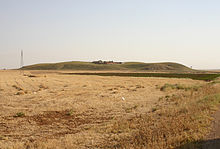Urkeš
Coordinates: 37 ° 3 ′ 25 ″ N , 40 ° 59 ′ 50 ″ E
Urkeš , also Urkesch , today Tell Mozan ( Arabic تل موزان) also (Girê Mozan) , is a Bronze Age settlement hill ( Tell ) in the northeast of Syria , which was settled in the late 4th to the middle 2nd millennium. The earliest settlement remains discovered so far come from the late Chalcolithic period at the end of the 4th millennium.
location
Urkeš is located on the upper Chabur about 5 km from the city of Amûdê , near the mouth of the Wadi Da'a , on the southern edge of the Tur Abdin , which was then probably called Nawar . It was due to the road that connected the Anatolian highlands in the north with its rich copper deposits with Mesopotamia, and the east-west route from the Mediterranean to the Zagros . Urkeš controlled trade in the upper Chabur region.
The average rainfall is 400–450 mm, so the cultivation of winter cereals is possible without any problems. Today the area is a sagebrush steppe , but in the Bronze Age the climate seems to have been much more humid. During the summer months, cotton is planted with artificial irrigation.
agriculture
According to preliminary archaeobotanical studies, barley ( Hordeum distichum ), emmer ( Triticum dioccocum ) and naked wheat ( Triticum turgidum ) were the most important cereal plants. Vetch ( Vicia ervilia ), chickpeas ( Cicer arietinum ), grass pea ( Lathyrus sativum ) and faba bean ( Vicia faba ) were also cultivated. In addition to figs , wine and flax are also documented by macro residues ; it is unclear whether the latter were domesticated. The crown vetch ( Coronilla sp.) Was perhaps brought in in the form of dung (sheep / goat) as fuel, Mediterranean mesquite ( Prosopis ) probably also served as fuel.
history
The city was probably founded by the Hurricans . Hurrian names such as B. Ewrim-Atal , an official at the time of Naram-Sin , are proven. It belonged to the Akkad Empire and after its end came under the influence of Mari , who had the city administered by a viceroy, who was not very popular with the population, as letters from the Mari archives prove.
archeology
Urkeš has been excavated by Giorgio Buccellati and Marilyn Kelly-Buccellati since 1984 . From 1998 to 2003 the German Orient Society also took part in the excavations.
The Tell consists of a lower town of around 130 hectares, which has so far been largely unexplored, and an upper town of 30 hectares. Among other things, a royal palace (AK building) was located here. A seal imprint with animal fighting scenes on a palace door belongs to Tar'am-Agade, a daughter of Naram-Sins , who the excavators believe was Queen of Urkeš. That would prove that the city belonged to Akkad at that time .
Underground adobe burial chambers, perhaps family tombs, have also been discovered in some of the buildings.
Ruler
So far the names of seven rulers have been handed down, the order of which is not entirely clear.
- Te'irru belongs to the ancient Babylonian period and is around 1800 BC. Chr. To be set.
The rulers of the 2nd millennium all have Hurrian names.
- Tišatal could have been a predecessor of Tupkiš
- Tupkiš , who calls himself Endan and LUGAL , seems to belong to the reign of Maništušu
- Satar-mat , his son, the outgoing Akkad-time or in the Isin-Larsa-time to put
- Atal-šen and Ann-atal : outgoing Akkad period or into the Isin-Larsa period
literature
- Giorgio Buccellati, Marilyn Kelly-Buccellati: The archaeological project Girê Mozan / Urkeš . MDOG 131, 1999, pp. 7-16.
- Simone Riehl: First results of the archaeobotanical investigations in the central upper town of Tall Mozan / Urkeš . MDOG 132, 2000, pp. 229-238.
- Alice Bianchi, Heike Dohmann-Pfälzner, Eva Geith, Peter Pfälzner, Anne Wissing: The architecture and stratigraphy of the central upper town of Tall Mozan / Urkeš (= studies on the urbanization of northern Mesopotamia, Series A: excavations 1998–2001 in the central upper town of Tall Mozan / Urkeš vol. 1). Harrassowitz 2011. ISBN 978-3-447-05891-9
- Alice Bianchi, Anne Wissing: The small finds (= studies on the urbanization of northern Mesopotamia, Series A: excavations 1998–2001 in the central upper town of Tall Mozan / Urkeš, vol. 2). Harrassowitz 2010. ISBN 978-3-447-05936-7
- Katleen Deckers, Monika Doll, Peter Pfälzner, Simone Riehl (Eds.): Development of the Environment, Subsistence and Settlement of the City of Urkeš and its Region (= Studies on the Urbanization of Northern Mesopotamia, Series A: Excavations 1998-2001 in the Central Upper Town from Tall Mozan / Urkeš vol. 3). Harrassowitz 2010. ISBN 978-3-447-06386-9
- Conrad Schmidt: The ceramics of the early Ǧazīra V to old Ǧazīra II period (= studies on the urbanization of northern Mesopotamia, series A: excavations 1998–2001 in the central upper town of Tall Mozan / Urkeš, vol. 4). Harrassowitz 2013. ISBN 978-3-447-06825-3
Web links
- The Tall Mozan / Urkesch excavation project in northeast Syria. DOG, University of Tübingen
- Urkesh urkesh.org (Eng.)
- Giorgio Buccelati, Marilyn Kelly Buccelati: Reflections on the functional and historical purpose of the AP Royal Palace in Urkeš. Report on the 13th campaign in Tall Mozan / Urkeš: excavations in area AA, June – August 2000. (PDF; 5.3 MB) In: MDOG 133, 2001, pp. 59–96

